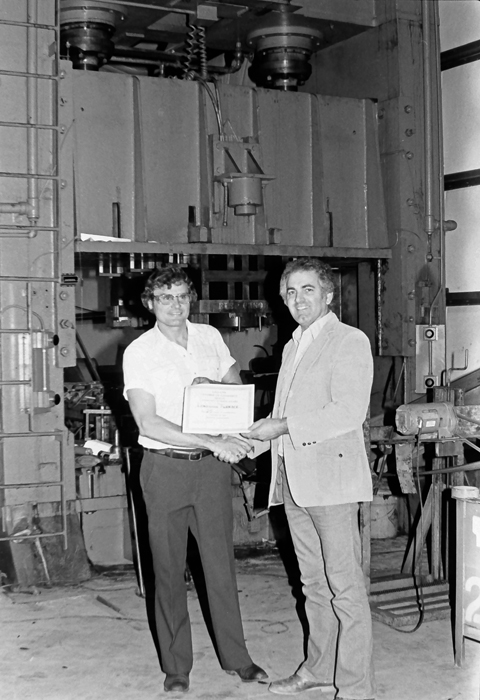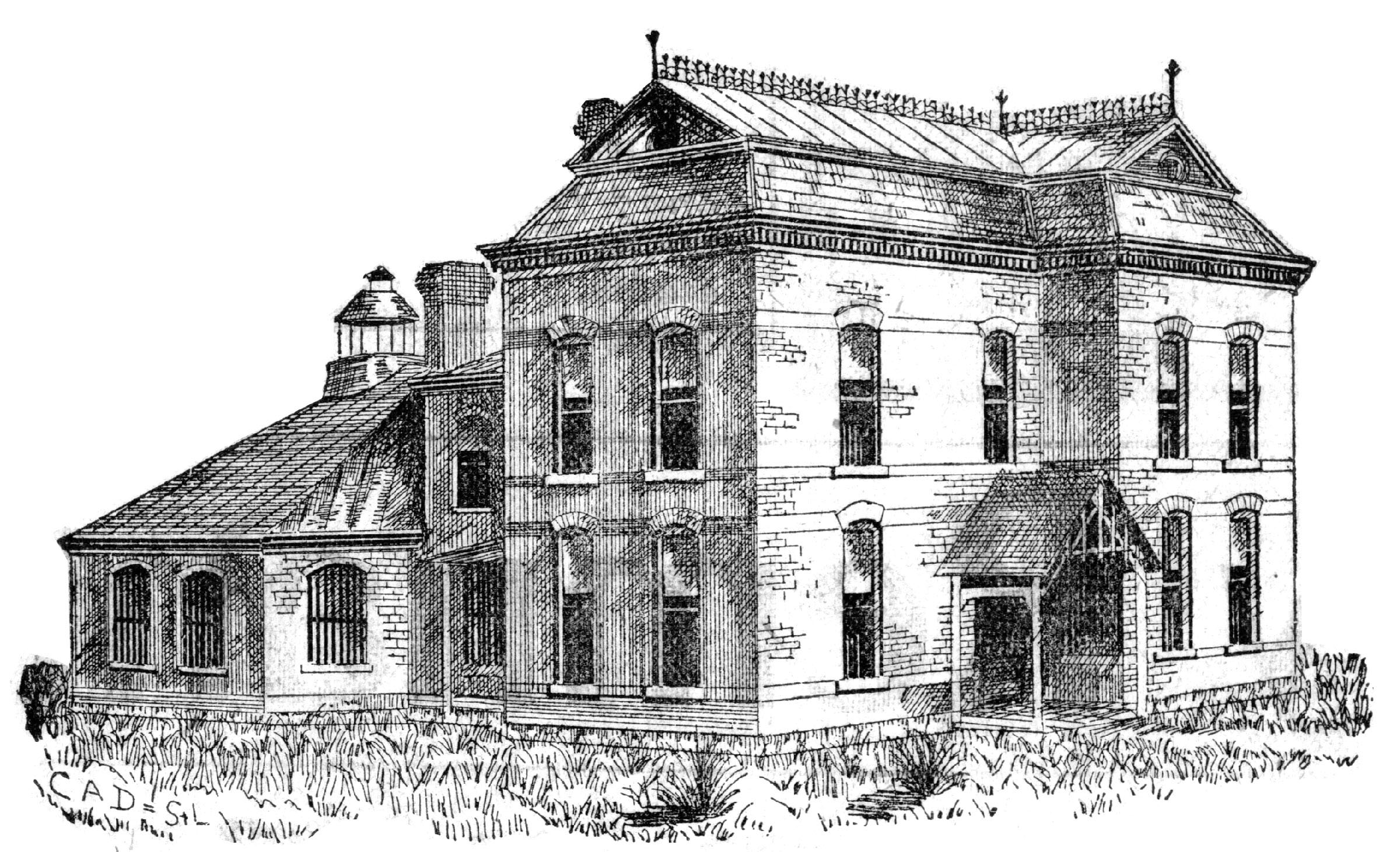Steve Perry has worked at Landmark through the fire of 1992 and the flood of 1993, through prosperity and struggle, since starting to work in August of 1983.
“There have been some really good years and none that have been really bad,” he said. “At the end of the year, the sales team and all the hard working employees always seem to find a way to pull us out of a slump.”
In 2016 Steve now works as the production manager at Landmark, but he began by packing stoves into crates back when the company was known as Longwood Furnace.
A great idea originating back on the farm…
The Longwood Automatic Stove Company was established in 1953 in a workshop. It began assembly-line production in a new building on the Critten farm, located about five miles east of Gallatin, in 1958-59. Wayne Critten got the idea for the stove after seeing so much timber go to waste on the farm.
“Well, something about clearing the brush and trees and then burning them always offended dad,” said son Kenny in an article from an earlier North Missourian. “It went against his grain. He knew there was energy in the wood and it seemed to be a waste.”

This was the first facility housing the production of Longwood Furnaces, located on the Critten farm in 1958.
Wayne liked to tinker so he went and got an old water heater and turned it on its side and that was the first furnace. It just burned wood. But it worked. Electricity was being installed into homes, but folks still needed a wood supply and the product appealed to South Missourians who preferred to cut their own wood.
The business grew. It outgrew the little shop. Additions were made. Offices and a warehouse were added. The original 12,000 sq.ft. plant was torn down and replaced.

Building expansions became necessary as Longwood Furnace Corporation grew and later as the business emphasis changed to metal fabrications of Landmark Manufacturing. (date unknown)
On the market, Longwood furnaces were, well, selling hot. Soon the furnace designs evolved into dual fuel units to burn wood and oil or to burn wood and gas simultaneously.

Don Critten of Longwood Corporation is shown with a later model of the duel fuel furnace produced at Gallatin, MO, and sold nationwide. The top door opens to a chamber for burning long pieces of wood; underneath is the bottom door for ash removal. Thermostat controls not only managed the forced air furnace for heating homes but furnace controls could be set so that a second fuel, either propane gas or stove oil, could be used when the time to renew wood for burning lapsed. (date unknown)
When the furnace sales cooled in the late 1970s, the company got out of heating equipment all together and moved into contract metal manufacturing and stamping. By 2016 Landmark’s workspace had grown to around 600,000 square feet under roof. The world class custom metal fabrication plant produces equipment for automotive, agriculture, military, and produces its own smoker/cooker.

Under the direction of Don Critten along with the ingenuity of his brother, Kenny, Landmark Manufacturing emerged as a leading metal fabricator in the entire Midwest. The brothers relocated metal stamping presses from Detroit, MI, and later incorporated robotics and other cutting edge technologies to put the Gallatin business into the ranks of world-class metal fabricators.

Building expansions became necessary as Longwood Furnace Corporation grew and later as the business emphasis changed to metal fabrications of Landmark Manufacturing. (date unknown)

Growing from Longwood Furnace Corporation to Landmark Manufacturing put the Gallatin industrial business to the forefront among major employers in the 9-county Green Hills region. Here Landmark Mfg. president Don Critten accepts a certificate of recognition from Gallatin community leader Carl Abbs. (date unknown)
From one generation to another…
From Longwood to Landmark, the business has always been a family affair. Wayne Critten’s sons, Don and Kenny, succeeded their father and extensively expanded the business before they retired in 2009, turning the reins over to their sons: Kent and Kevin (Kenny’s sons) and David and James (Don’s sons).

Donny and Kenny Critten of Gallatin, MO
Landmark workers tool, weld, stamp, paint, assemble and finish just about anything, from sliders that go under tractor trailers to smokers. Warehouse and transportation back these processes. The company is especially proud of its system of quality assurance.

Metal fabrications meant building all sorts of metal products in all sorts of sizes. Here steel spools are loaded for shipment from Landmark Manufacturing of Gallatin, MO (date unknown)
Missouri Gov. Mel Carnahan Tours Landmark in 1993

Building expansions became necessary as Longwood Furnace Corporation grew and later as the business emphasis changed to metal fabrications of Landmark Manufacturing. (date unknown)
Hugh stamping presses to laser to robotics…
Multi-ton presses and an automatic paint line share the Landmark floor space with computers, lasers and robots. In October 1992, a paint line fire caused over $1 million in damages. The company was back in full production in about a month.
“New products depend on whether we have the room and equipment to take them on,” said Steve. “Some projects don’t work out. The lasers have been a good investment, as have the C&C break presses and the milling machines.” A new prototype ATV is the latest project.

in 2016 as much as 95 to 98 percent of welding on a line of cookers is performed by robots. Operators like Olen Hoskins of Hale, MO, and Stacy Gardner of Trenton, MO, insure production deadlines are met.
Aussies soon to get taste of home
Good-One barbecue smoker/grills are being readied to ship to Australia, marking a first for Landmark, located east of Gallatin. There are 36 open range and 36 Marshall grills plus accessories’ set to go to the land Down Under.
Landmark Custom Metal Fabrication Plant has shipped to Japan, Germany and Norway before, but this is the first time the company has sent a product to Australia. All of the grill is made at Landmark, except for the springs, wheels and placard. Landmark sells over 500 smokers annually, plus accessories like covers and shelving.
Kelly (Critten) Gray handles orders and paper work for the Good-One. The cookers are sent to Kansas City for high heat powder coat paint that will withstand up to 1200 degrees.
The grills are boxed individually in customized containers to maximize number of cookers for shipping.

The product line at Landmark Mfg. in 2016 included outdoor food cookers.

The product line at Landmark Mfg. in 2016 included outdoor food cookers.
Many people are involved in the production of the grills. For instance, Kevin Wynne of Coffey and Randy Hawkins of Chillicothe load and secure cookers into shipping containers; Shane Tharp of Bethany is supervisor of this area. Wilbur Roberts of Spickard handles foam packing for the Marshall grills. Jeff Nelson of Cameron is the quality inspector and Mike Kirk of Ridgeway does grill assembly.
Through the years Steve Perry had the opportunity to go into the tooling department. He next supervised the press room, then back to the tool room as supervisor.
Now working as production manager, Steve Perry attributes a lot of his knowledge and abilities in metal fabrication to the times he worked alongside Junior Burke of Gallatin, another longtime employee now retired.
“I’m a firm believer that you’re only as good as the people you’re surrounded by and over the years at Landmark I’ve been surrounded by really great people,” he said.

As Landmark’s production manager in 2016, Steve Perry attributes a lot of his knowledge and abilities in metal fabrication to the times he worked alongside Junior Burke of Gallatin, another longtime employee now retired.

